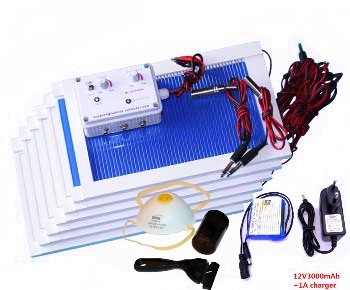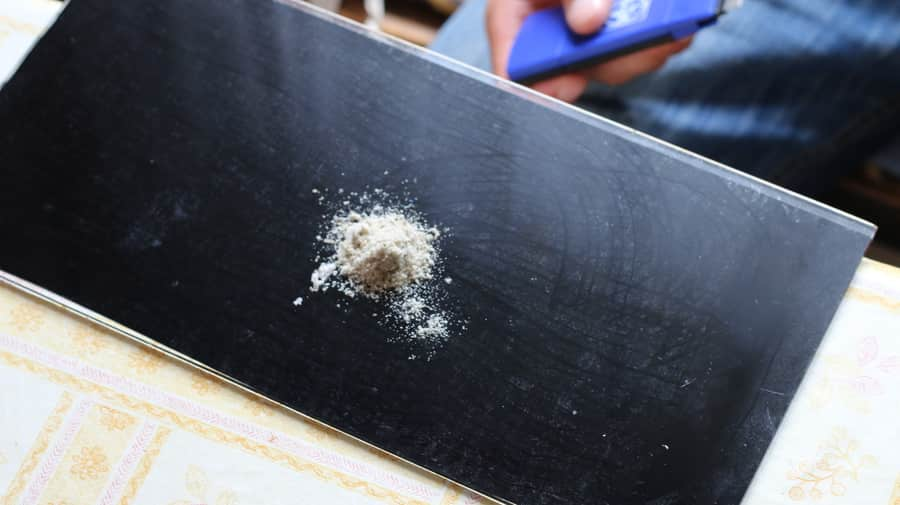Bee venom is used in the pharmaceutical industry, and more recently it became popular in the beauty industry too, which branded it as a natural Botox. Below are our suggestions for everyone interested in collecting bee venom, as well as our tips and tricks based on more than 10 years of collecting and selling bee venom.
- To start collecting bee venom, you need (besides the bees 🙂 ),
-
- A bee venom collector set (panels and a receptacle box)
- A power source (12 V)
- Parallel extension cord (optional)
- Dark jar ( or something similar)
- Scraper
- Face mask (optional)
- How to set up your bee venom collector
-
- Place all panels and boxes on top of hives.
- Remove the entrance reducers if you have them. Place panels on the entrance of beehives and connect panels to receptacle boxes.
- Connect all boxes with a parallel extension cord connected to a power source (12V).
- Turn on each receptacle box and let the bees do their magic.
- How often should you collect bee venom?
-
- We collect every 3 to 4 days for 2 hours, with a 25ish min break in between. We get anywhere from 0.25 to 0.85 grams per hive each round.
- To find the level that works best for each colony, observe each colony and see how the bees react to different levels (1-10) – you can adjust these levels on the collector, 1 being the lowest, and 10 the highest level of vibration. Do not worry, neither 10 nor 1 kill the bees.
- There are different ways of collecting bee venom:
-
- Placing the venom collector panel on the entrance of the hive. This is the most efficient way of collecting bee venom. This method ensures that the collecting panels will be attacked by the bees that leave and return as well as the bees that are protecting the hive.
- Placing the panel on the top of honey frames. This is the least efficient way of collecting bee venom because the smallest amount of bees will attack the bee venom collector.
- At the bottom of the brood chamber. This method isn't good because by doing so, you will definitely have the highest amount of foreign material mixed with bee venom (pollen, nectar, honey, dead bees, other impurities). These foreign materials change the composition of bee venom, degrading the physiological activity of bee venom.
- In the hive, as a frame replacement. This could potentially be a very efficient way of collecting bee venom if you collect it by night and close the hive (trap all the bees inside the hive). However, collecting during the night might be extremely tricky for you and the bees; the bees are more agitated during the night, so they are more likely to sting you and die. You could set up everything the day before and turn on the collectors during the night, but if you leave the collected venom overnight in the hive, it might oxidate and lose quality, which means a lower price for you ( if you want to sell bee venom).
- How to store bee venom – 2 most important methods
-
- Bee venom is a colorless fluid, but it becomes a white powder after drying. Remove it from the glass plate with a scraper as soon as possible and store it in a dark glass jar. If you don't, it will oxidate, and the color will change to dark yellow. A good way to store it would be putting bee venom in a freezer, but freeze-drying is probably the most effective method of preserving bee venom. The better and sooner you store it properly, the more active ingredients it will have, and the better price it will get on the market. The pharmaceutical industry prefers better ((high quality)) bee venom, while the beauty industry usually goes for cheaper bee venom.
- When to collect bee venom (apitoxin)?
-
- You should collect bee venom during the spring-summer season.
- Some people prefer to collect bee venom during the day, while others during the night. As mentioned before, collecting during the NIGHT could potentially be a very efficient way of collecting bee venom, because this is the time when most bees are inside the hive. However, collecting during the night might be extremely tricky for you and the bees; the bees are more agitated during the night, so they are more likely to sting you and die. You could set up everything the day before and turn on the collectors during the night, but if you leave the collected venom overnight in the hive, it might oxidate and lose quality, which means a lower price for you ( if you want to sell bee venom).
- We collect during the DAY, from morning till evening. In our opinion, collecting during the day is the best because it allows observing the bees during the collection process and adjusting the bee venom collecting box (time-frequency and voltage) as necessary. Collecting bee venom isn't a job for someone who wants to turn on the collector, leave, and return after a certain period of time; this way you wouldn't yield the maximum amount of bee venom, only a certain part of that.
Note –What to consider while buying a bee venom collector
When researching bee venom collectors, pay attention to panels and boxes, and ask yourself the following questions:
Panels:
- What kind of materials are wires made of?
- We use stainless steel: it's indestructible, it won't rust, and with proper care, it will practically last forever. With some other bee venom collectors, you have to be cautious and think about potential wire replacements in the future because the materials used don't last extremely long. With our bee venom collector, this is not the case.
- How are wires attached?
- Pay attention to how the wires are attached to the panel frame; on some collectors the attachment is weak and the wires then tend to fall out of their place and move left/right. Our panels are constructed in such a way that the wires won't move at all, so no need to worry about that.
- What kind of material are panel frames made of?
- Our material is durable but light and very easy to work with (you can make a hole if you need). This material is much better than for instance wood, iron and plastic. Wood can get rotten, iron can rust, plastic is more fragile. So, these materials are prone to damages, while the material we are using is versatile (it won't get rotten and it won't rust) and a chance of breaking it is very low.
Box:
-Pay attention to what options are on the boxes.
-We didn't bother with putting anything unnecessary on our box because we wanted to keep it simple and extremely easy to use. The box lasts long, all components are of high quality, it is manufactured in a precise way, and tested several times before being delivered to you.
Good luck!







Comments
I have a question…so if bees attack the panels, how do they not die? Are you saying they can release bee venum by not stinging?
Hi Bianca, this is a very good question.
When a bee stings a soft place (for example human skin), she loses her stinger and a part of her body. However, when she stings a hard place like a glass surface in our bee venom collector, a bee is unharmed because it can not penetrate the glass.
When the bees come to the panel they can feel low frequency that irritates them, and so they put their stinger in between two wires. At that point, the bees eject bee venom to the glass panel and return to the hive. So, they actually sting the air and release their bee venom in the air above the glass panel.